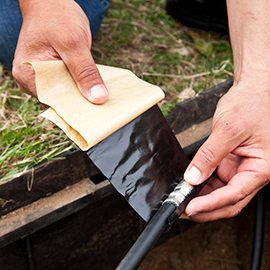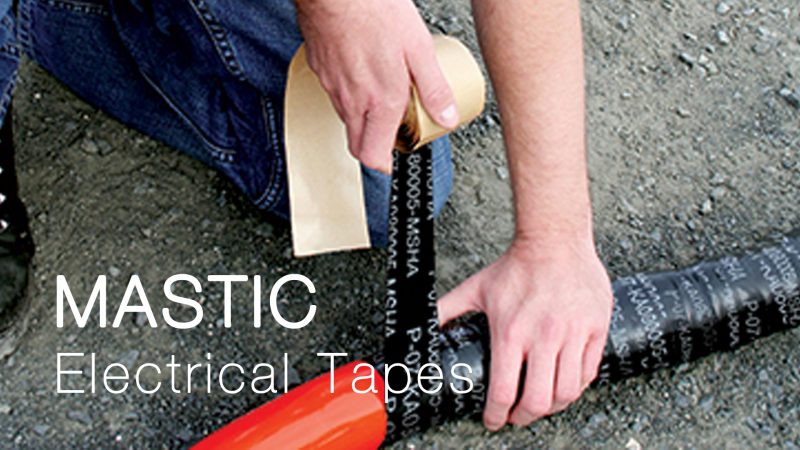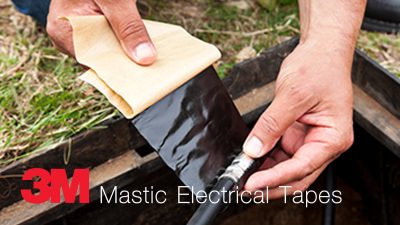Chapter 3
Putty on a roll. Or on a pad.
The term “mastic” is widely used in the construction industry, especially by tile setters. Many electricians don’t realize that the gooey electrical tape they use to resist moisture is also a mastic. But this mastic rubber material is specially formulated for use as a dielectric insulator.
When you are working with odd shaped components or needing to tuck in some insulation where your tape won’t reach; mastic is the product to use. Think of it as putty on a roll.

Moisture Resistance
Humidty? Moisture? Wrap it up!
This tape has healing properties.
In addition to low-voltage electrical insulation, mastic tape offers the best moisture resistance of any electrical tape made by 3M. They create a barricade around splices and terminations, so that they are resistant to contaminants and particles that can corrode your wire and connections. Mastic tapes are often used in outdoor applications because the rubber is ‘self-healing’, meaning that when it is punctured, the material will flow to fill in the void.
We recommend it for use within industrial environments where steam and aerosols are commonly present, and outdoor environments where connections need to resist humidity and moisture.
Padding, Smoothing, Shaping
Built for the odd shape and the long stretch.
Pad your connections to save you ‘dough’.
Mastic tapes provide mega-stretch−up to 1000 times their original length. Sharp edges and bolted connections create potential puncture risks and failure modes for your splices which can result in costly downtime and repairs. With multiple configurations and thicknesses of moldable and stretchable sheets, rolls, putty and laminated combinations, you can shape, smooth and pad just about any electrical connection.
Pest Control
Built for the odd shape and the long stretch.
What’s eating your cables?
There is another mastic application electricians may be surprised to learn about. Mastic tape can be used to deter pests. Fire ants in the Southeastern U.S. create headaches for electricians by attacking pad mounted transformers, traffic control panels and ground level air conditioning units. *According to research done at Texas A&M University, the insects are attracted to the electrical fields, especially around relay switches. Power surges caused by these pests can cost thousands of dollars in electronics repairs or even human lives if those relays operate train switches.
Pests and rodents can cause havoc. Help reduce your regular maintenance costs with a simple mastic solution.
*Merchant, Mike. “Insects in the City: Fire ants shock homeowners.”
http://insectsinthecity.blogspot.com/2009/06/fire-ants-shock-homeowners.html (accessed September 15, 2017).
Laminated Solutions (Mastic + Vinyl or Rubber)
Jackets required. This tape can ooze.
Mastic is going to flow. So, for the better mechanical protection and to help prevent it from making a mess in your application; mastic should be completely overwrapped with another protective material like vinyl (PVC) or rubber tape.
Mastic Electrical Tape Do’s and Dont's
Jackets required. This tape can ooze.
DO
- Use on split bolt connections to smooth out irregular shapes
- Apply like putty in the inside ‘elbow’ of a multi-conductor cable where tape can’t quite reach
- Keep a roll of mastic on the truck or in the plant for quick and critical fixes
- Use underground to help protect from moisture that may corrode conductors
- Use indoors where water and aerosols are sprayed or present
- Use on solar panels and wind towers where there’s a consistent need for UV protection
- Use in environments that require higher continuous operating temperatures
- Use as a moisture seal at ground wire exit points
DON'T
- Use on connections where re-entry is needed without pre-wrapping with varnished cambric or backwound (adhesive side out) vinyl
- Use mastic on a roll when a pad will do a more efficient job; taping motor leads for instance
- Use as the primary insulation on voltages >1kV. (Can be combined with rubber tape for higher voltage applications)
- Use without the proper protective jacket
- Apply in temperatures below 32°F (0°C) unless it’s a premium product like Scotch® Vinyl Mastic Tape or Pads 2200 and 2210 which can be applied down to 0oF (-18oC)













